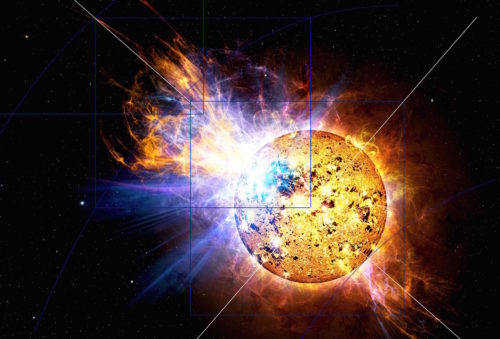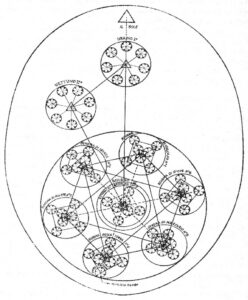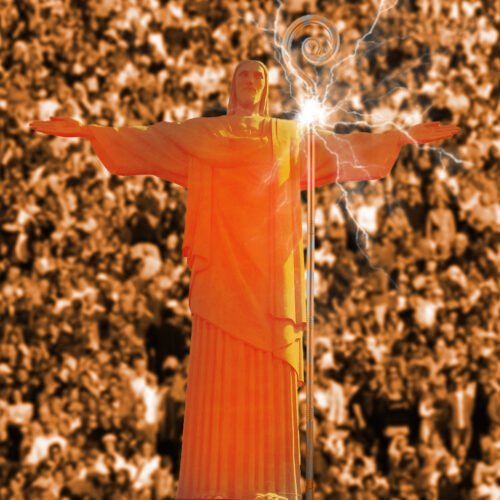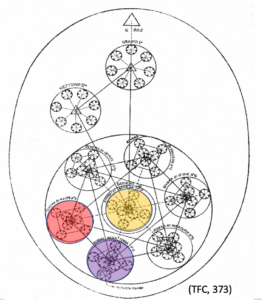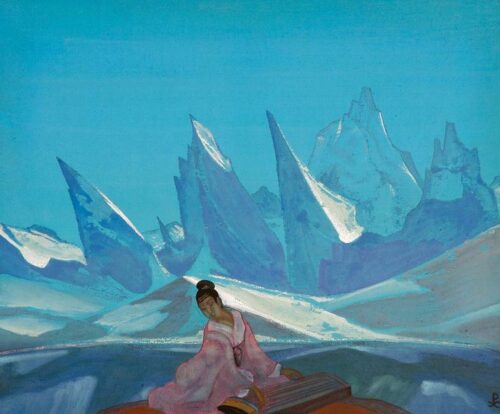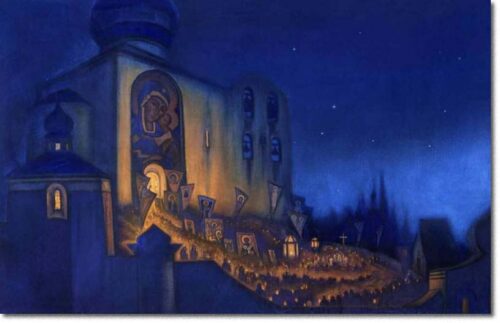Source: https://blog-en.theplanetarysystem.org/2024/02/17/the-law-of-sacrifice/
Among the seven laws of soul or group life that reveal to us how to serve the demands of the Plan of evolution in a more powerful and purposeful way, we examine in depth today* the first of these Laws, the Law of Sacrifice, which is associated with the 4th Ray of Harmony through conflict, and is therefore particularly related to the 4th Human Kingdom and the 4th Creative Hierarchy.
- The Law of sacrifice.
… This law of sacrifice, which is the first of the laws to be grasped by the human intelligence, and is therefore the easiest for man to understand (because he is already governed by it and, therefore, aware of it) came to its first major expression during this slowly disappearing age, the present age, the Piscean age. This law has always been functioning and active in the world, for it is one of the first of the inner subjective laws to express itself consciously, and as an active ideal, in human life. The theme of all the world religions has been divine sacrifice, the immolation of the cosmic Deity through, the process of universal creation, and of the world Saviours, by Their death and sacrifice as a means of salvation and eventual release and liberation.
… this dominant world law governs the appearing and the disappearing of universes, of solar systems, of races and of nations, of world leaders and world rulers, of incarnating human beings and of revealing Sons of God.
Let us see if we can interpret or define the true significance of this law, which is in reality the expression of a divine impulse, leading to a defined activity, with its consequent and subsequent results and effects…
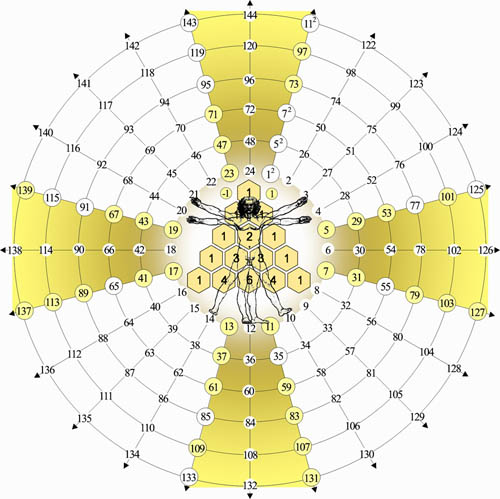
a) THE SIGNIFICANCE OF THE LAW OF SACRIFICE
It means the impulse of giving. The whole secret of the doctrines of “the forgiveness of sins” and of the “at-one-ment” lies hid in this simple phrase. It is the basis of the Christian doctrine of love and sacrifice. Hence the emphasis laid, in the Piscean Age and through the influence of Christianity, upon just these two things,—forgiveness and atonement.
That man, as usual, distorted and misinterpreted the teaching and the truth, and that it fell, as does all else at present, under the glamour and illusion of the astral plane, plus the Piscean influence, is true. Man’s thought dominated and distorted the ideal and produced such a damnable doctrine as the elect of God, the chosen of the Lord, or the sole people to benefit by the sacrifice and death of the great Son of God, and who pass, due to the merits of that vicarious death, into a state of bliss in heaven, simply because of an emotional choice, which ignores millions of those who have made no such choice, nor had the opportunity to do so. The symbolic activity of the great Teacher of Nazareth will be properly understood and its significance will be properly appreciated only when group implications are more carefully studied, the meaning of sacrifice and of death come into their rightful place in the human consciousness, and the law of giving, with all that that entails, is correctly understood and applied. Those who thus sacrifice are:
The Solar Deity who gave His life to the universe, to the solar system, to the planet, and the manifested worlds consequently appeared. The cosmic Deity has likewise done the same… It was His impulse, His will, His desire, His incentive, His idea and purpose to appear. The creative act then took place, and the process of manifestation began its cyclic evolutionary existence. The Cosmic Christ was crucified upon the cross of matter, and by that great sacrifice opportunity was offered to all evolving lives in all kingdoms of nature and in all created worlds. Thus they could progress. The work, in space and time, and the stupendous march of living beings towards an at present unrealised goal, began… All that the intelligent human being can grasp as he looks back over the history of the planet (as far as modern history can give it to him) is that there has been:
- Progress in the human power to be conscious.
- A growing and paralleling refinement of the forms of life in the various kingdoms of nature.
- An intensification of conscious activity, on a developing scale of rapid living, that tends constantly to transcend time as we know it.
- An expanding realisation of progress from one dimension to another, until today we talk in terms of a fourth dimensional state of consciousness and can grasp the fact that five or six dimensions are beautifully possible.
- An increasingly scientific control of the elements in which we live, and of the forces of nature. Today we talk in terms of air mastery just as five hundred years ago (when such a thing was deemed impossible) they talked in terms of the mastery of oceans. We are offsetting the gravitational pull of the earth so that we can “fly into the face of the sun”.
- From the instinctual life of sense consciousness in material forms, we have progressed to the intellectual life of self-conscious human beings and to the intuitive realisations of those who are beginning to function as superhuman entities.
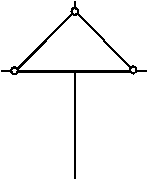
All this has been brought about as the result of the determined, conditioned activity of a Great Life, Which chose to make a major sacrifice and to be crucified upon the cardinal Cross of the Heavens, and thereby pass through a cosmic initiation…
It will be apparent, therefore, why it is the energy of the fourth ray which is related to this Law of Sacrifice, and who in this fourth planetary scheme and in our fourth globe, (the Earth globe) so much emphasis is laid upon this Law of Sacrifice, “the Law of those who choose to die”.
The fourth ray of conflict (conflict with a view to eventual harmony) is at present not one of the manifesting rays, yet—in the light of the larger cycle—this ray is a major controlling factor in our earth evolution and in the evolution of our solar system, which is one of the fourth order. The realisation of this may indicate why our little planet, the Earth, is of such apparent importance in the solar system. It is not simply because we choose to think so and thus feed our own arrogance, but it is so primarily because the fourth ray of conflict and this first law are—in time and space—dominating factors in the fourth kingdom in nature, the human kingdom. Our planet, the fourth in the series of divine expression with which we are associated, has a peculiar relation to the position of our solar system in the series of solar systems which constitute the body of expression for The One About Whom Naught May Be Said.
It must never be forgotten that this fourth ray of conflict is the ray whose energies, rightly applied and understood, bring about harmony and at-one-ment. The result of this harmonising activity is beauty, but it is a beauty that is achieved through struggle. This produces a livingness through death, a harmony through strife, a Union through diversity and adversity.
The sacrifice of the solar angels [the Fourth human Hierarchy] brought the fourth kingdom in nature into being. The “returning nirvanis” (as they are called in esoteric literature), with deliberation and full understanding, took human bodies in order to raise those lower forms of life nearer to the goal. These were and are ourselves. The “Lords of Knowledge and Compassion and of ceaseless persevering Devotion” (who are ourselves) chose to die in order that lesser lives might live, and this sacrifice has made possible the evolution of the indwelling consciousness of Deity. This consciousness, having worked its way through the subhuman kingdoms in nature, needed the activity of the solar angels to make further progress possible. Herein lies:
- Our service to God [to the evolutionary Purpose], through sacrifice and death;
- Our service to other souls, through deliberate self-sacrificing purpose;
- Our service to other forms of life in other kingdoms.
All this involves the death and sacrifice of a Son of God, a solar angel, for, from the angle of Deity, descent into matter, manifestation through form, the taking of a body, extension of consciousness through the process of incarnation, are all occultly considered to be death. But the angels “chose to die, and in dying, lived”. Through their sacrifice, matter is lifted up into Heaven. It is this theme which fills the pages of The Secret Doctrine, and which is discussed in greater elaboration in A Treatise on Cosmic Fire. The sacrifice of the angels, the death of the Sons of God, the immolation of the mystic Christ, the crucifixion in time and space of all living entities, called souls—this is the theme of those books… Then comes a life wherein, in some form or another, he portrays or works out within himself, but also before the watching world, that great symbolic drama which we call: The Sacrifice of a World Saviour.
This is the theme of the historical romance of all those great Sons of God who down the ages, have arrived at an understanding of the significance of the divine purpose of God, of the Word incarnated through a planet, of those solar angels who are themselves, the Word incarnate through a human form. Whether they enact this drama, as did the Christ, so as to present to man the symbolism of death and sacrifice, or whether they enact this drama, as did the Buddha, so as to demonstrate to man the sacrifice and death of personal desire (to mention only two of the manifested Sons of God, the Christ and the Buddha), the theme remains the same,—the death of that which is lower in order to release that which is higher, or—on a larger scale—the death of that which is higher in the order and scale of being, in order to release that which is lower.
But the lesson needs to be learned (and it is the lesson which man is now engaged in learning) that death as the human consciousness understands it, pain and sorrow loss and, disaster, joy and distress, are only such because man, as yet, identifies himself with the life of the form and not with the life and consciousness of the soul, the solar angel, whose awareness is potentially that of the planetary Deity, Whose greater awareness (in His turn) is potentially that of the solar Deity. The moment a man identifies himself with his soul and not with his form, then he understands the meaning of the Law of Sacrifice; he is spontaneously governed by it; and he is one who will with deliberate intent choose to die. But there is no pain, no sorrow, and no real death involved.
This is the mystery of illusion and glamour. From these two imprisoning factors all World Saviours are free. They are not deceived. It is well, in passing, to point out here that in the New Age, we shall enlarge our concept of this term World Saviour. At present we apply it predominantly to those souls who emerge upon the teaching ray, the second or Christ ray. They enact the drama of salvation. But this is an error, due to the overpowering emotional glamour of the Piscean Age. This astral influence has its roots in the past Atlantean civilisation, which preceded ours. In that age, the astral body was the subject of attention. Much that happens today, and which may develop, has its roots in that aspect of energy. Seeds sown at that time are now brought to flower. This is very good and necessary, even if distressing in experience.
But the World Saviours must be recognised as coming forth to serve the race, with sacrifice of some kind along many lines and in many forms. They may be great rulers, or dictators, politicians, statesmen, scientists and artists. Their work is the work of salvage, of restitution, or renovation and revelation, and, through the sacrifice of themselves, they accomplish it. As such, they must be recognised for what they are. Now they are misunderstood, misinterpreted, and judged by their mistakes more than by their aims. But they are dedicated souls. They rescue; they lift; they integrate; they illumine; and the net result of their work, from the angle of ultimate history, is good.

This Law of Sacrifice and the impulse to give can also be traced throughout every kingdom in nature. It is typified for us in the basic sacrifices which take place between the various kingdoms. The essential qualities of the minerals and chemicals of the earth are an instance in point. They are needed by other forms of life and are donated to man through the medium of the vegetable kingdom and through the water which he drinks, and thus, even in the first and densest kingdom in nature (whose consciousness is so far removed from ours) does this process of giving hold good.
But the tracing of this Law of Sacrifice in the subhuman kingdoms is not possible here, and we must confine our attention to the world of human living and consciousness.
b. THE WORK OF SALVAGE OR SALVATION
The Law of Sacrifice means also salvage and underlies all the evolutionary processes and particularly does this emerge into clear significance in the human family. The instinct to betterment, the urge to progress (physical, emotional and intellectual), the effort to ameliorate conditions, the tendency to philanthropy which is so rapidly taking hold of the world, and the sense of responsibility which does make men realise that they are their brother’s keeper, are all expressions of this sacrificial instinct. This factor, though not unrecognised by modern psychology, is of far wider significance than has yet been realised. This instinctual tendency is the one that itself governs the Law of Rebirth. It is the expression of a still greater factor in the creative process. It is the major determining impulse which impelled the Soul of God Himself to enter into form life; which impels life, upon the involutionary arc, to progress down into matter, producing thus the immanence of God. It is that also which drives humanity forward into its wild struggle for material well-being. It is that too which urges man eventually to turn his back upon the “world, the flesh and the devil”, as the New Testament puts it, and orient himself to the things of spiritual import. The prodigal son sacrificed the Father’s home when he chose to wander forth into the far country. He wasted and sacrificed his substance through the use he made of the experience of life on earth, until he had exhausted all his resources and there was naught left but the eventual sacrifice of what he held so dear, but had discovered to be so unsatisfying. For these things of lesser values, he had sacrificed the higher values, and had to return again whence he came. Such is the life story of all the sons of God who came into incarnation, as given to us under the symbolism of the Bible. But the theme in all the world Bibles is the same.
This urge to sacrifice, to relinquish this for that, to choose one way or line of conduct and thus sacrifice another way, to lose in order eventually to gain,—such is the underlying story of evolution. This needs psychological understanding. It is a governing principle of life itself, and runs like a golden pattern of beauty through the dark materials of which human history is constructed. When this urge to sacrifice in order to win, gain or salvage that which is deemed desirable is understood, then the whole clue to man’s unfoldment will stand revealed. This tendency or urge is something different to desire, as desire is academically understood and studied today. What it really connotes is the emergence of that which is most divine in man. It is an aspect of desire, but it is the dynamic, active side and not the feeling, sensuous side. It is the predominant characteristic of Deity.
It is of interest, however, for students of esotericism to note that this urge to salvage and to sacrifice in order to redeem works out in different ways in the different planetary schemes. Each Ray Lord of a scheme, manifesting through a planet, expresses this urge in varying ways, and each expression is so different from the others that it is hard for a human being to do more than sense that method which exists on our own particular planet. Initiates know that the varying psychological characteristics of the ray Lives condition most peculiarly the method of expressing sacrifice, during the course of manifestation. The great stream of living energy which is manifesting itself in our Earth scheme of evolution is conditioned by a temperament, an attitude and an orientation that is that of a “Divine Rebel”. It is only rebellion that produces pain and sorrow, but this rebellion is inherent and innate in the Deity of our planet Himself, the “One in Whom we live and move and have our being”.
It is, therefore, a tendency greater than the individual unit. …
The same conditions which blend the Law of Sacrifice with pain and sorrow and difficulty are found also on the planet Mars and on the planet Saturn. They are not found on the other planets… our Earth is not a sacred planet. [that is to say it still expresses the Ray of Personality, not yet that of Its Soul].
Saturn, Mars and our Earth constitute, in a curious esoteric manner, the personality of a stupendous ray Life, Whose energy is that of the third Ray. There are, as has been stated elsewhere, seven sacred planets but ten planetary schemes, and in three cases, (those of the three major rays) three planets constitute the personality of each ray Life. Some esoteric thinkers believe that there are twelve planets to be considered in our solar system, and there is a basis for their conclusion. The personality of this third ray Life functions through the following planets:
- The mental body expresses itself through the medium of the planet Saturn.
- The astral body expresses itself through the planet Mars.
- The physical body expresses itself through the planet Earth.
The potency of this Life is such that He requires three complete schemes—all three closely allied and interdependent—through which to express Himself. Uranus, Jupiter and Venus are similarly allied in order to manifest or express a great Life [whose energy is that of the Second Ray]…
- Only three planetary schemes are aware of pain and sorrow as we understand those terms; none of them know it so well or feel it so much as does our planetary Logos.
- Pain and sorrow are the result of rebellion, and of divine discontent. The instinct to betterment, based on discontent, has necessarily involved the planetary temperament or attitude which recognises the dualities.
- There is a stage to be reached in the human consciousness, where that which lies behind the dualities—the stage of essential oneness—can, and will be recognised.
- When this takes place, the consciousness of our humanity will then merge with that underlying consciousness of the whole, which recognises no pain or sorrow and has, therefore, slipped out of the realisation which predominantly governs the consciousness of the three great Lives in our solar system [Earth, Saturn and Mars].
- It is this dimly sensed truth which lies behind the highest type of metaphysical thought… and the emphasis laid by Christianity and the esoteric schools upon the at-one-ment.
This instinct towards betterment through sacrifice is itself diverse.
There is, first of all, the instinct towards individual betterment, which leads to selfishness, to a grasping, and to an orientation of the materially-minded towards material possessions.
There is, secondly, the instinct towards an ameliorating of the conditions of other people, first from a selfish motive (the avoiding of personal distress at the sight of suffering), and secondly, through pure, disinterested service, which is a quality of the soul.
There is, finally, the active application and the complete sacrifice of the lower separated self through the power to “stand in spiritual being” which necessarily infers that one has reached that state of consciousness which transcends what may be called, symbolically the “Earth, Saturn and Mars” state of consciousness.
Let it not, however, be forgotten that the contribution to these three great planetary Lives, as They embody pre-eminently the Law of Sacrifice, through pain and rebellion, is a major contribution to the whole, and greatly enriches the sum total. The units of divine life and the atoms of electrical energy who pass through these three planetary schemes are subject to them in order to acquire that psychic sensitivity which would otherwise be impossible. Only those units of life who are coloured predominantly by the third ray of activity pass for any length of time through these three schemes. A hint is here conveyed as to the prevalence of third ray Monads among the sons of men. The ray of active intelligence, expressing itself through the seven ray types, is above everything else the ray upon which the majority of human monads will, particularly, at this time, be found. We shall, therefore, find the following psychological types colouring the bulk of our humanity, and the ray of active intelligence expressing itself through:
- Will, evoking divine purpose.
- Love, expressing divine quality.
- Intellect, as the reflector of the Intuition.
- Conflict, producing harmony.
- Knowledge or science, leading to radiance.
- Idealism, establishing the divine pattern.
- Ritual or organisation, manifesting Deity.
… The Law of Sacrifice, therefore, can never be eliminated in our Earth scheme, as far as the human and subhuman reactions to sorrow and pain are concerned, nor can it be eliminated on the planets Saturn and Mars. It is relatively unknown in the other schemes. Bliss and Sacrifice are synonymous terms as far as our solar Logos is concerned, and also for the majority of the planetary Logoi. This must be remembered.

A touch of this freedom from the limitations of pain and sorrow can be found among the more advanced sons of men on Earth, who know the ecstasy of the mystic, the exaltation of the initiate, and the exquisite agony of sacrifice or of any feeling which is carried forward to the point of sublimation.
When this point has been reached, the mechanism of suffering and the ability to register sensuous perception is transcended, and momentarily the man escapes on to the plane of unity. Here there is no pain, no sorrow, no rebellion and no suffering. When the living, vibrating antaskarana or bridge is built, this “way of escape” becomes the normal path of life. Escape from pain is then automatic, for the centre of consciousness is elsewhere. In the cases mentioned above, and where the antaskarana is not a consummated, established fact, the tiny thread of the partially constructed “way of escape”, under tremendous pressure and excitation, shoots forward like a quivering band of light, and momentarily touches the light that is the Self. Hence ecstasy and exaltation. But it does not last, and cannot be consciously recovered until the third initiation has been taken. After that the “way of escape” becomes the “way of daily livingness” (to translate inadequately the occult and ancient phrase). Then pain is steadily transcended, and the pairs of opposites—pleasure and pain—have no longer any hold over the disciple.
All this constitutes the theme of esoteric psychology and, when rightly understood, will explain:
- The Saturnian influence in human life.
- The cessation of rebellion, or the ending of the Martian influence.
- The building of the antaskarana, which releases the man from the control of personality life.
- The evocation of the group consciousness.
- The consequent negation of pain and sorrow.
- Entrance into Nirvana, and the beginning of the real Way.
The Law of Sacrifice means also:
c. THE RELINQUISHING OF GAIN
This is the basic theme of The Bhagavad Gita. In that treatise on the soul and its unfoldment, we are taught to “perform action without attachment”, and thereby lay the foundation for later relinquishings which can be effected without pain and the sense of loss, because we have acquired the power, latent ever within ourselves, to detach ourselves from achieved possessions.
This law works out in many ways, and it is not possible to do more than indicate a few of those general significances which embody the major lessons of every disciple.
First, the soul must relinquish the personality. For ages, the soul has identified itself with the lower personal self, and through the agency of that lower self has gained experience and acquired much knowledge. The time has to come when that agency is “no longer dear” to the soul, and their respective positions are reversed. No longer is the soul identified with the personality but the personality becomes identified with the soul and loses its separate quality and position. All that has been acquired through age-long struggle and strife, through pain and pleasure, through disaster and satisfied desire, and all that the wheel of life, which has turned ceaselessly, has brought into the possession of the soul—All has to be relinquished. Life, for the disciple, becomes then a series of detaching processes, until he has learnt the lesson of renunciation [Fourth Initiation].
The sequence is, first dispassion, then discrimination, and finally detach-ment. On these three words must all disciples meditate, if they are ever to reap the fruits of sacrifice.
“Having pervaded the worlds with a fraction of Myself, I remain”. Such is the theme of the soul’s endeavor, and such is the spirit which must underlie all creative work. In this thought lies the clue to the symbol of the Law of Sacrifice—a rosy cross with a bird flying over it. This is the loved cross (rose being the colour of affection), with the bird (symbol of the soul) flying free in time and space.
Secondly, the soul has also to relinquish not only its tie and its gain through contact with the personal self, but it has most definitely to relinquish its tie with other personal selves.
It must learn to know and to meet other people only on the plane of the soul. In this lies for many a disciple a hard lesson. They may care little for themselves and may have learnt much personal detachment. Little may they cherish the gain of contact with the lower personal self. They are learning to transcend all that, and may have transcended to a great degree, but their love for their children, their family, their friends and intimates is for them of supreme importance and that love holds them prisoners in the lower worlds. They do not stop to recognise that their love is primarily love for the personalities, and only secondarily for the souls. Upon this rock, many disciples are for lives broken, until the time comes when, through pain and suffering and the constant losing of that which they so much cherish, their love enters into a newer, a higher and a truer phase. They rise above the personal, and find again—after felt loss and suffering—those whom now they love as souls. Then they realise that there has been gain and not loss, and that only that which was illusory, ephemeral and untrue has disappeared. The real Man has been gained and can never be lost again… to hold, one must detach, and to keep, one must release. Such is the law.
The soul has also to learn to relinquish the fruits or gains of service and learn to serve without attachment to results, to means, to persons or to praise…
In the fourth place, the soul has to relinquish also the sense of responsibility for that which other disciples may do. So many earnest servers hold on to their fellow workers, and do not relinquish their hold upon them or upon their activities upon the outer plane. This is a subtle error, for it masks itself behind a sense of righteous responsibility, an adherence to principles as they appear to the individual, and the accumulated experience of the disciple,—which is necessarily incomplete experience. The relation between disciples is egoic and not personal. The link is of the soul and not of the mind. Each personality pursues its own course, must shoulder its own responsibilities, work out its own dharma, and fulfil its own karma, and so answer for itself to its Lord and Master, the Soul. And answer there will be. Does this itself sound of the nature of separation and aloneness? It does, as far as outer activities are concerned. Only as servers cooperate from the standpoint of an inner subjective linking can a united world be carried forward.
At this time in the history of the world and its periodical salvaging from conditions which are wrecking the current civilisation, it is necessary that aspirants grasp the fact that that salvaging process must be carried on under the Law of Sacrifice, and that only a relative outer unity can be at this time achieved. Not as yet is the vision seen with a sufficient clarity by the many servers, to make them work with perfect unanimity of purpose and objective, of technique and method, or complete understanding and oneness of approach. That fluid, perfect cooperation lies as yet in the future. The establishing of an inner contact and relationship, based on a realised oneness of purpose and soul love, is magnificently possible, and for this all disciples must struggle and strive. On the outer plane, owing to the separative mind during this age and time, a complete accord on detail, on method, and on interpretation of principles is not possible.
But—the inner relationships and cooperation Must be established and developed, in spite of the outer divergences of opinion. When the inner link is held in love, and when disciples relinquish the sense of authority over each other and of responsibility for each other’s activities, and at the same time stand shoulder to shoulder in the One Work, then the differences, the divergences, and the points of disagreement will automatically be overcome.
There are three rules which are important to disciples at this time.
First, see to it that you permit no rift to appear in the inner relation in which you stand to each other. The integrity of the inner band of servers must be preserved intact.
Secondly, pursue your own duty and task, shoulder your own responsibility, and then leave your fellow disciples to do the same, free from the impact of your thought and criticism. The ways and means are many; the points of view vary with every personality. The principle of work is love for all men and service to the race, preserving at the same time a deeper inner love for those with whom you are destined to work. Each soul grows into the way of light through service rendered, through experience gained, through mistakes made, and through lessons learnt. That necessarily must be personal and individual. But the work itself is one. The Path is one. The love is one. The goal is one. These are the points that matter.
Thirdly, preserve ever in work the attitude of mind which must grow out of the two rules above, faithfully followed. Your point of view and consciousness are your own, and therefore, are for you, right. Not necessarily is that which seems so clear to you and of such vital importance to you, of the same value or importance to your brothers.
Your important principle may be realised by an abler mind than yours and by a more advanced disciple as embodying an aspect of a greater principle, an interpretation of a principle, correct and proper at a certain time, but capable of a different application at another time, and by another mind.
Under the Law of Sacrifice these three rules might be interpreted thus:
- Relinquish or sacrifice the age-old tendency to criticise and adjust anothers work, and thus preserve the inner group integrity. More plans for service have gone astray and more workers have been hindered by criticism than by any other major factor.
- Relinquish or sacrifice the sense of responsibility for the actions of others, and particularly of disciples. See that your own activity measures up to theirs, and in the joy of struggle and on the way of service the differences will disappear and the general good will be achieved.
- Relinquish the pride of mind which sees its way and its interpretations to be correct and true, and others’ false and wrong. This is the way of separation. Adhere to the way of integration which is of the soul and not of the mind.
These are hard sayings, but they are the rules by which the Teachers on the inner side, guide Their actions and Their thoughts, when working with each other and with Their disciples. The inner integrity is necessarily a proven fact to Them. To the disciple it is not. But to the inner Teachers, the outer differences are abhorrent. They leave each other free to serve the Plan. They train Their disciples (no matter what their degree) to serve that Plan with freedom, for in freedom and in the sense of joy and in the strength of inner cooperative love is the best work done. It is sincerity for which They look. The willingness to sacrifice the lesser when the greater is sensed is that for which They search. The spontaneous relinquishing of long-held ideals when a greater and more inclusive presents itself is Their guide. The sacrifice of pride and the sacrifice of personality when the vastness of the work and the urgency of the need are realised, sway Them to cooperation. It is essential that the disciples shall learn to sacrifice the non-essential in order that the work may go forward. Little as one may realise it, the many techniques and methods and ways are secondary to the major world need. There are many ways and many points of view, and many experiments and many efforts—abortive or successful, and all of them come and go. But humanity remains. All of them are in evidence of the multiplicity of minds, and of experiences, but the goal remains. Difference is ever of the personality. When this Law of Sacrifice governs the mind, it will inevitably lead all disciples to relinquish the personal in favor of the universal and of the soul, that knows no separation, no difference. Then no pride, nor a short and myopic perspective, nor love of interference (so dear to many people), nor misunderstanding of motive will hinder their cooperation with each other as disciples, nor their service to the world.”
(Alice A. Bailey, Esoteric Psychology vol. II, pp. 87-109)
* Today in the Heaven of Causes, the consonant heliocentric conjunction between Mercury (4th Ray) and Pluto (1st Ray of Will and Power) takes place.
